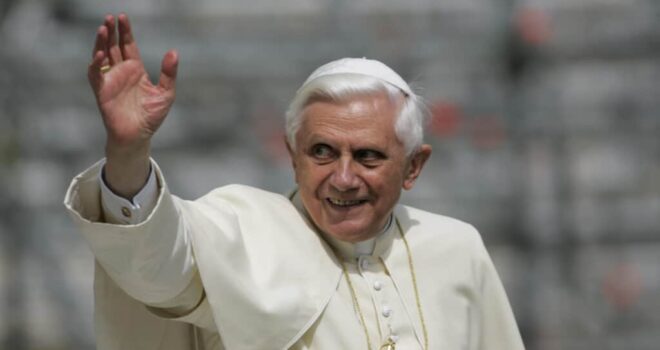“I had studied Ratzinger’s writings in advance and especially his diagnoses of the times. And I was somewhat stunned to see that Ratzinger’s analyses of the development of society had been largely confirmed. In addition, none of the contemporary witnesses I interviewed, fellow students, assistants, companions, who really knew Ratzinger, could confirm the image of the hardliner, on the contrary. With the exception of people like Hans Küng and Jürgen Drewermann, his notorious opponents.” – Peter Seewald
Joseph Ratzinger, as theologian and cardinal, returned to the question “Smaller, purer church?” over the years. This writer submits that, taken in circumspect, including his Pontificate, Benedict XVI’s comments and writings provide greater clarity and insight into this question and the thought of the two-hundred sixty fifth pope of the Roman Catholic Church (excluding the never consecrated Stephen II).
Today’s Church could be faced with a situation in which it is undermined, according to Benedict, by the temptation to reduce priests to “social workers” and it and all its work reduced to a mere political presence. “From today’s crisis, will emerge a Church that has lost a great deal.”
In an interview published in 1997 in Salt of the Earth, he explained it this way:
Maybe we are facing a new and different kind of epoch in the church’s history, where Christianity will again be characterized more by the mustard seed, where it will exist in small, seemingly insignificant groups that nonetheless live an intense struggle against evil and bring good into the world—that let God in.
The standard argument, unfortunately accepted by many in and out of the Church, is that Pope Benedict wanted to harken back to a more ardent, orthodox church, even if the effect was to drive people away. But as is the case with much discourse about this pope, the truth is a bit more complicated than that.
“I don’t get any sense of him wanting to purge or anything,” said Christopher Ruddy (at the time of Benedict’s consecration), an assistant professor of theology at the University of St. Thomas in St. Paul, Minn. “But I think he is willing to say what he thinks are hard truths, or unpopular truths.”
Yet, these “hard truths” many in the Church hierarchy and laity talk about deal primarily with concerns like sexuality, the proper celebration of Mass, standards for receiving communion, role of laity in the Church, role of women in the church—and whether they will scare off Catholics who disagree.
These so-called “hard truths” were not the truths Benedict was concerned about. He wanted to preserve the traditions which correlate with the first seven ecumenical councils of the Church, the Marian Dogmas and the First Vatican Council’s—Pastor aeternus—Papal infallibility. Discipline and polity were of lesser concern to him except as they relate to the traditions of the Church. His views on sexuality, the Mass and communion are about preserving traditions which help foster observance of and obedience to the dogma of the Church.
From its first days, the church struggled with sects and schisms and later with the Reformation. These actually dealt with true apostasy and heresies against orthodox beliefs since the first council of Nicaea in 325. But in modern times it is rent by parochial interests, sex scandals, and dissent on contraception etc. These are not “hard truths;” rather, they are “unpopular truths” of discipline—not doctrine.
What was of greater import to Pope Benedict was that the church was besieged by a secular culture that he believed offered only relative truths—not objective truths—which fix values of definitive moral comport. The “hard truths” complained of were merely signs, symptoms of the decline of Catholicism in particular and Christianity in general in a secular society.
It seems that the eternal question for the church—the faithful—remains: What do Catholics need to do and believe in order truly to belong?
The question may be eternal, but for Benedict the answer was equally ever-present, found in the doctrines taught through the Magisterium of the Church. Belief comes from the precepts of those promulgations—what we do comes from belief in them. Those beliefs are the “hard truths”—the rest are merely “unpopular truths” of discipline and polity promoted by our secular culture.
Pope Benedict’s own record on the idea of a smaller church is multilayered. On one hand, he has issued documents like “Dominus Iesus”—a declaration by the Congregation for the Doctrine of the Faith, signed by its then prefect, Joseph Cardinal Ratzinger. The declaration was approved by Pope John Paul II and was published on August 6, 2000.
It is known for its elaboration of the Catholic dogma extra ecclesiam nulla salus (lit. “no salvation outside the Church”). It is a foundational statement that the Catholic Church is the sole true Church founded by Jesus Christ.
On October 1, 2000, during one of his angelus, Pope John Paul II stated he had approved “Dominus Iesus” in “a special way.” He added: “This confession does not deny salvation to non-Christians, but points to its ultimate source in Christ, in whom man and God are united.”
As the thought of Ratzinger matured, there developed a sanguine relationship (intellectually and personally) between these two tradition-oriented popes. John Paul II was responsible for bringing then Cardinal Ratzinger to the Vatican to head the Congregation for the Doctrine of the Faith. Although they had their differences, Benedict clearly affirmed John Paul II’s “special way” of accepting “Dominus Iesus.” Hence, the sharp edges with which Benedict is often maligned using that document is without substance and thus merit.
But perhaps the most striking thing about Pope Benedict was that he does not seem to speak with any sense of satisfaction or inevitability about the prospect of a smaller church. “Most people admit that at the present stage of things in Europe, the number of baptized Christians is simply dwindling,” he said in a 2002 book of interviews, God and the World. But he continues, “we simply have to face up to it.” In that book, in fact, he actually opposes the idea of being a “closed club.”
“I have nothing against it, then, if people who all year long never visit a church go there at least on Christmas Night or New Year’s Eve or on special occasions,” he says, “because this is another way of belonging to the blessing of the sacred, to the light.”
Looking in circumspect at the life, teachings and writings of Pope Benedict, one may infer that he was very much a realist. The issue of a smaller church seems mostly to be informed by and defined in terms of the losses of the Church in the developed world, as growth in the developing world has pushed church membership to more than 1 billion.
Notre Dame’s Church Life Journal carried an essay which contained a poignant comment by Cardinal Ratzinger. Western civilization, he surmised, will at some point tire of modern liberalism’s secular relativity and its loneliness of despair—irrespective of the size of the Church.
Ratzinger quotes in Faith and the Future from the diary of Simone de Beauvoir:
If on an evening I happened to have drunk a glass too many, it could easily happen that I wept buckets. My old longing for the absolute awoke; I discovered afresh the vanity of human striving and the menacing nearness of death.
It seems that a cultural milieu so patently hostile to the Christian faith and the idea of transcendence—the finitude in which de Beauvoir lived a life foreign to Catholic moral philosophy could not suppress the heart from longing for infinitude. In a moment of self-reflection, a discontent with one’s existence imposes itself to express what Kierkegaard called the “concept of anxiety.”
Kierkegaard’s 1844 work, The Concept of Anxiety, describes the nature of dread, placing the domain of anxiety within the mental-emotional states of human existence that precede the qualitative “leap of faith” to the spiritual state of Christianity. It is through anxiety that the self becomes aware of its dialectical relation between the finite and the infinite, the temporal and the eternal.
Ratzinger called this phenomenon an “abysmal melancholy,” yet with it the deceptions of our secular age become revealed for the heart to “see.” Pope Benedict XVI believed the dogma of the church would ultimately prevail in the human conscience—irrespective of the number of its faithful—or the size of the Church.
Photo on Britannica










